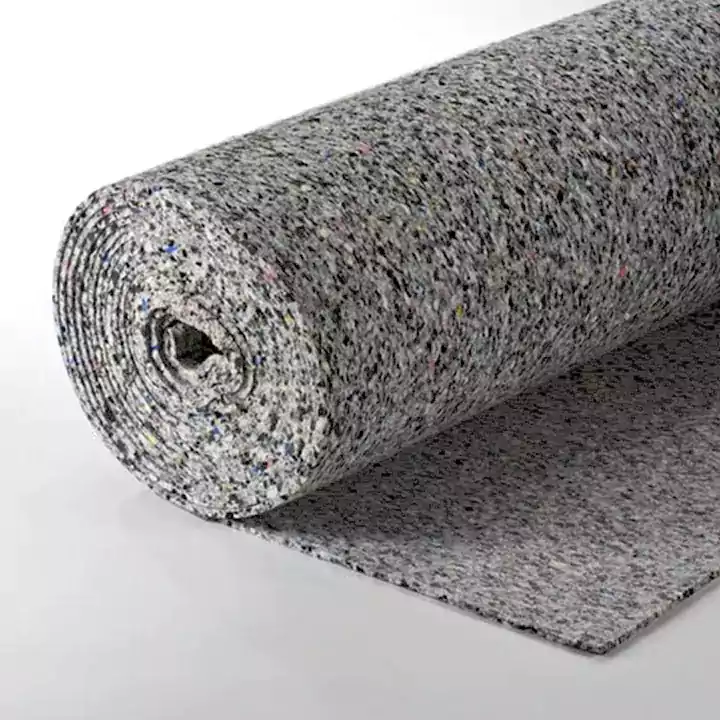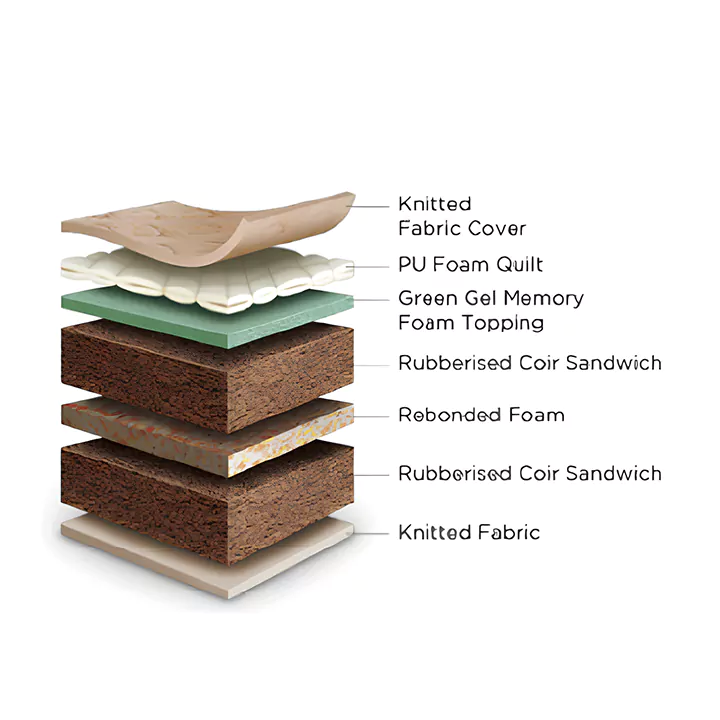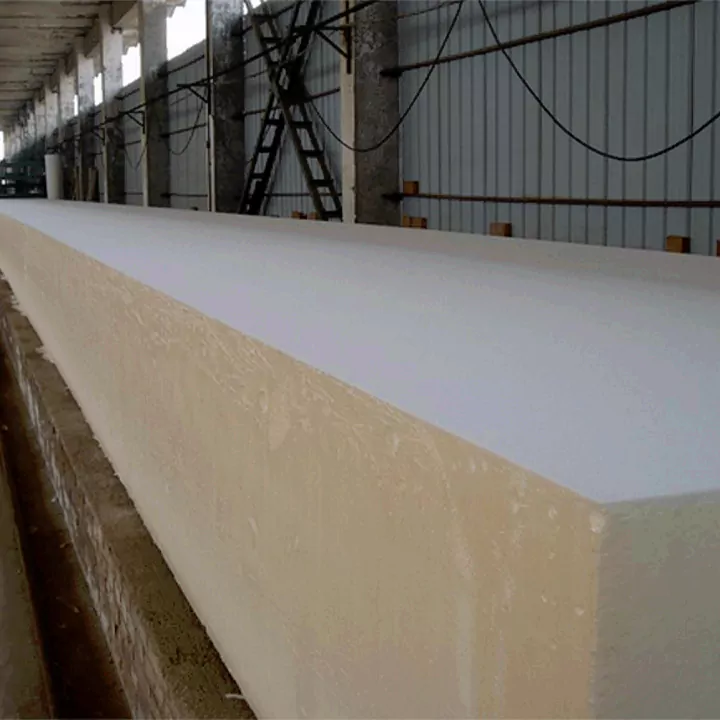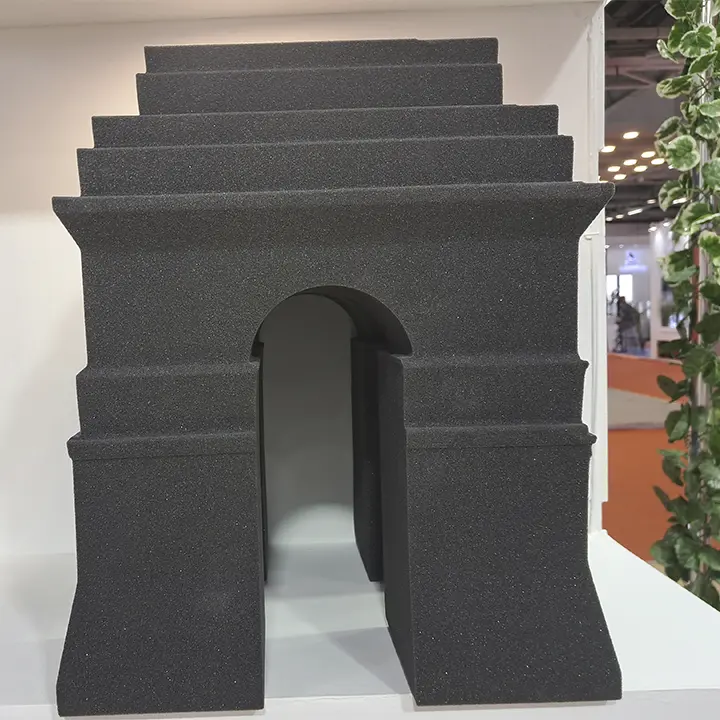Rebounded Foam
Rebounded Foam Manufacturing: Process, Applications & Market Insights
Rebounded foam is a versatile and eco-friendly material crafted by recycling foam scraps into high-density blocks. This innovative manufacturing process not only helps reduce foam waste but also produces a durable and supportive product that serves a wide range of applications across industries.
The global rebounded foam market is growing steadily, fueled by increasing demand for sustainable and cost-effective materials. Leading manufacturers like Sarva Foam Industries and Jumax Foam are pioneering high-quality rebounded foam products, catering to the needs of various sectors including furniture, automotive, construction, and packaging.
Manufacturing Process
The production of rebounded foam involves several key steps:
Shredding: Scrap foam pieces from various sources are shredded into small, uniform particles.
Mixing: The shredded foam is blended with bonding agents and sometimes additives to improve durability and performance.
Pressing: The mixed foam particles are compressed under high pressure and heat, bonding them into dense, solid blocks. This step ensures firm support and consistent texture.
Cutting: The large rebounded foam blocks are then cut into sheets or custom shapes based on specific industry requirements.
Applications
Thanks to its density, resilience, and sustainability, rebounded foam finds uses in numerous industries:
Mattresses & Bedding: Provides firm support and comfort, enhancing sleep quality.
Automotive Industry: Used in seating cushions, headrests, and sound insulation components.
Flooring Underlay: Acts as a durable cushioning layer under carpets and flooring to reduce noise and improve comfort.
Packaging: Protects delicate items during transit with excellent shock absorption.
Sports Mats & Cushioning: Offers impact resistance and comfort in gym mats and athletic padding.
Acoustic Insulation: Helps dampen sound in buildings and automotive interiors.
Benefits of Rebounded Foam
Eco-Friendly: Made from recycled foam scraps, it reduces landfill waste and supports environmental sustainability.
High Density and Durability: Offers long-lasting support and resilience, outperforming many other foam types.
Excellent Support: Ideal for applications that require firmness, such as mattresses and floor underlays.
Cost-Effective: More affordable than virgin foam materials due to its recycled content.
Versatile Applications: Used widely from bedding and furniture to automotive parts and soundproofing.
Good Shock Absorption: Effectively absorbs impact and vibrations, suitable for sports and packaging needs.
Customizable Density and Firmness: Manufacturers can tailor properties to fit specific requirements.
Conclusion: Rebounded foam stands out as a sustainable, durable, and versatile material in today’s foam industry. Its eco-friendly nature combined with high performance and wide-ranging applications makes it a smart choice for manufacturers and consumers alike. As demand for sustainable solutions rises, rebounded foam’s role in modern manufacturing is only set to grow.
Mattresses and Well-Being: Connecting Sleep, Health, and Industry Insights
Why Mattresses Matter: Sleep, Health, and Market Insights
On average, we spend about one-third of our lives sleeping—roughly 25 to 30 years on a mattress. Adults typically sleep 7-9 hours nightly, totaling 2,500 to 3,285 hours yearly. This makes investing in a good-quality mattress essential for supporting your health and well-being over decades.
Why Mattresses Are Important for Good Sleep:
Spinal Alignment: Proper support keeps your spine neutral, preventing pain.
Pressure Relief: Even weight distribution reduces pressure on sensitive areas.
Comfort & Support: Balances softness and firmness for better rest.
Improved Sleep Quality: Minimizes discomfort and motion transfer.
Health Benefits: Enhances circulation, reduces back pain, and improves breathing.
Global Mattress Market Overview
The mattress market is booming, valued at around $46.48 billion in 2024 and expected to reach $67.51 billion by 2030, growing at a CAGR of 6.5%. Foam mattresses dominate with about 45% market share, followed by innerspring and hybrid types. Residential use makes up 78% of demand, with healthcare and hospitality also key sectors. North America leads the market, while Asia-Pacific is the fastest-growing region.
Common Mattress Types
Innerspring: Steel coils provide support and breathability.
Memory Foam: Molds to body shape, offering pressure relief.
Latex: Durable, hypoallergenic, and responsive.
Hybrid: Combines coils and foam for balanced comfort.
Airbeds: Adjustable firmness via air chambers.
Waterbeds: Unique contouring, less common today.
Where Mattresses Are Used
Mattresses are everywhere—from bedrooms and hotels to healthcare, dorms, military, RVs, childcare centers, and even outdoor camping. Each setting demands different features for comfort, durability, and safety.
Final Thoughts
Your mattress is more than just a sleeping surface—it’s a foundation for good health and restorative sleep. Choosing the right mattress tailored to your needs ensures you wake up refreshed, pain-free, and ready for the day.
Good Sleep
The Importance of Good Sleep: Benefits, Essentials, and Best Practices
Good sleep is more than just rest—it’s a vital foundation for our physical health, mental well-being, and overall quality of life. While we sleep, our body undergoes essential processes like tissue repair, immune system strengthening, and memory consolidation. These functions help us wake up feeling refreshed, alert, and ready to take on the day. On the other hand, insufficient or poor-quality sleep can lead to fatigue, difficulty concentrating, mood disturbances, and a higher risk of serious health issues such as heart disease, diabetes, and obesity. Simply put, good sleep rejuvenates the body and mind, supports emotional balance, and enhances productivity, making it a cornerstone of a healthy lifestyle.
Benefits of Healthy Sleep
The advantages of consistent, restful sleep extend across multiple areas:
Improved Cognitive Function: Enhances memory, attention, and problem-solving skills.
Emotional Well-being: Helps regulate mood and reduces stress and anxiety.
Physical Health: Supports immune function, tissue repair, and cardiovascular health.
Energy Restoration: Recharges the body, increasing energy and alertness during the day.
Weight Management: Regulates hormones that control appetite, lowering obesity risk.
Better Performance: Boosts productivity, reaction times, and physical performance.
Reduced Risk of Chronic Diseases: Lowers the chances of diabetes, heart disease, and hypertension.
Hormonal Balance: Supports growth and stress hormone regulation.
The Role of Mattresses and Pillows in Good Sleep
A key to achieving high-quality sleep lies in the right bedding. Both mattresses and pillows play crucial roles in supporting your body for uninterrupted, comfortable rest.
Mattress: A well-designed mattress evenly distributes your body weight, maintains proper spinal alignment, and alleviates pressure points. This helps minimize tossing and turning, allowing you to stay asleep longer and wake up refreshed. Different firmness options ensure you can find one that fits your unique preferences—whether you need soft cushioning or firm support.
Pillow: The right pillow supports your neck and head, aligning your spine properly. Choosing a pillow with the appropriate height and firmness prevents neck strain and stiffness, enhancing comfort throughout the night.
Best Practices for Better Sleep
Improving your sleep quality involves more than just bedding. Here are some effective habits to help you rest better every night:
Maintain a Consistent Sleep Schedule: Go to bed and wake up at the same time daily—even on weekends—to regulate your internal clock.
Create a Relaxing Bedtime Routine: Engage in calming activities such as reading, gentle stretching, or meditation before sleep. Avoid screens at least an hour before bedtime.
Optimize Your Sleep Environment: Keep your bedroom cool, dark, quiet, and comfortable. Use blackout curtains, white noise machines, or earplugs if needed.
Choose Comfortable Bedding: Invest in a quality mattress and pillows tailored to your sleep position and support needs.
Limit Caffeine and Heavy Meals: Avoid caffeine, nicotine, and large meals close to bedtime as they can disrupt falling asleep.
Exercise Regularly: Moderate physical activity during the day can enhance sleep quality but avoid vigorous exercise close to bedtime.
Manage Stress: Practice relaxation techniques like deep breathing, progressive muscle relaxation, or journaling to reduce anxiety.
Limit Naps: Keep naps short (20-30 minutes) and avoid late afternoon naps that may interfere with nighttime sleep.
Avoid Alcohol Before Bed: Alcohol may initially induce sleepiness but disrupts sleep cycles and reduces quality.
Get Natural Light Exposure: Spend time outdoors during the day to help regulate your circadian rhythm.
Prioritizing good sleep by understanding its importance, investing in proper bedding, and adopting healthy habits can transform your well-being. Start making these changes today for a healthier, more energetic tomorrow.
Global Flexible Foam Production
Global Flexible Foam Production Overview: Raw Materials, Process, and Applications
Flexible polyurethane (PU) foam plays a vital role across multiple industries worldwide, from automotive and furniture to construction and packaging. Its unique cushioning, insulating, and sealing properties make it a go-to material for enhancing comfort, protection, and efficiency. In this blog, we explore the global landscape of flexible foam production, the raw materials involved, the manufacturing process, and key applications.
Global Market Landscape
The flexible foam market is a major segment of the global foam industry, valued in billions of dollars and growing steadily. This growth is fueled by expanding end-use industries and increasing consumer demand for products that prioritize comfort and thermal insulation.
Key Regions Driving Growth
Asia-Pacific: The fastest-growing region, driven by booming automotive manufacturing and construction sectors in countries like China, India, Japan, and South Korea.
North America: A mature, established market with strong demand in automotive seating, furniture, and bedding industries.
Europe: Focuses on innovation, sustainability, and high-performance foams, particularly for automotive and industrial applications.
Other Regions: Latin America and the Middle East are emerging markets with rising industrialization and urbanization, increasing foam demand.
Raw Materials Used in Flexible Foam Production
The quality and characteristics of flexible PU foam depend heavily on the raw materials used in production:
Polyols: These long-chain molecules react with isocyanates to form the foam’s flexible polymer structure. Different polyols affect softness, resilience, and durability.
Isocyanates: Typically methylene diphenyl diisocyanate (MDI) or toluene diisocyanate (TDI), isocyanates react with polyols to form polyurethane.
Blowing Agents: Responsible for creating the foam’s cellular structure by generating gas bubbles during the reaction. Common agents include water (producing CO₂) and physical blowing agents like hydrocarbons.
Catalysts: Speed up the chemical reaction, controlling foam rise and curing time.
Surfactants: Stabilize the foam cells during formation to ensure uniform cell size and prevent collapse.
Additives: Flame retardants, antioxidants, fillers, colorants, and antimicrobial agents may be added to enhance performance based on application needs.
Flexible Foam Production Process
The production of flexible PU foam is based on a chemical polymerization reaction:
Mixing Raw Materials: Polyols, isocyanates, blowing agents, catalysts, surfactants, and additives are precisely blended. The blowing agent initiates gas bubble formation.
Foaming Reaction: The mixture expands as gas bubbles develop, creating an open-cell foam structure.
Molding or Slabstock Formation: Foam is poured into molds for shaped parts or onto conveyors for continuous foam slabs.
Curing: The foam stabilizes and gains its final properties during curing.
Cutting and Finishing: After curing, foam slabs are cut into blocks or sheets and further processed, such as die-cutting for specific applications.
Applications of Flexible PU Foam
Flexible polyurethane foam’s versatility makes it ideal across a wide range of applications:
Automotive: Seat cushions, headrests, door panels, sound insulation, vibration dampening, and HVAC thermal insulation.
Furniture and Bedding: Mattresses, sofa cushions, pillows, and upholstered furniture.
Construction: Thermal insulation, acoustic panels, seals, and gaskets for walls, roofs, and HVAC systems.
Packaging: Protective foam inserts for fragile electronics, medical devices, and valuable goods during shipping.
Electronics: Cushioning sensitive components, managing heat, and isolating vibrations.
Medical: Patient positioning pads, prosthetics, and device cushioning.
Footwear: Insoles and padding that provide comfort and shock absorption.
Consumer Goods: Padding in appliances, sports equipment, and household products requiring protection and comfort.
Conclusion: Flexible polyurethane foam remains a cornerstone material in diverse industries due to its excellent cushioning, insulating, and protective properties. Supported by a growing global market, evolving raw materials, and advanced production techniques, flexible foam continues to innovate and adapt to meet the increasing demands of modern applications.
Die-Cut PU Foams
The Role of Die-Cut PU Foams Across Industries
Die-cut polyurethane (PU) foams are essential components used across many industries to improve comfort, protection, and efficiency. Precisely cut into custom shapes, these foams fit perfectly in applications ranging from automotive parts and electronics to building insulation and packaging.
Their main functions include sealing gaps, cushioning delicate components, reducing noise and vibrations, and providing thermal insulation. Thanks to their consistent thickness and easy integration, die-cut PU foams streamline manufacturing and enhance product quality.
Industries Served by Die-Cut PU Foams
Die-cut polyurethane foams are used across a wide range of industries thanks to their versatility and performance:
Automotive: Sealing, cushioning, noise reduction, and thermal insulation in doors, dashboards, HVAC, and engine compartments.
Construction: Insulation, sealing, and vibration damping in walls, roofs, windows, and HVAC systems.
Electronics: Protecting sensitive components, cushioning, and thermal management in devices and appliances.
Packaging: Custom foam inserts for protecting fragile and high-value goods during transport.
Medical: Cushioning and protecting delicate medical devices and equipment.
Consumer Goods: Adding comfort and durability in furniture, footwear, and household appliances.
Industrial Equipment: Vibration isolation, sealing, and thermal protection in machinery and tools.
Key Applications:
Sealing and Gaskets: Creating airtight and watertight seals in automotive doors, HVAC systems, and machinery.
Noise and Vibration Reduction: Used in engines, appliances, and industrial equipment to absorb vibrations and dampen sound.
Thermal Insulation: Maintaining temperature control in construction, refrigeration, and electronics.
Cushioning and Protection: Safeguarding delicate electronics, medical devices, and packaged goods.
Packaging: Custom foam inserts protect fragile items during shipping.
Interior Components: Enhancing comfort and durability in automotive interiors, furniture, and consumer products.
Benefits of Die-Cut PU Foams:
Precision Fit: Custom shapes with consistent thickness.
Comfort & Safety: Reduces noise and cushions impacts.
Thermal Efficiency: Provides insulation to improve energy use.
Durability: Resistant to wear, moisture, and chemicals.
Lightweight: Helps reduce overall weight.
Design Flexibility: Adaptable shapes and firmness.
Cost-Effective: Easy to produce and install.
Common Die-Cutting Machines:
Flatbed Die-Cutters: For precise cuts in medium to large runs.
Rotary Die-Cutters: High-speed cutting of repetitive shapes.
Laser Die-Cutters: Accurate, intricate cuts for detailed designs.
Waterjet Cutters: Cutting thick or complex shapes without heat damage.
Clicker Presses: Manual or semi-automatic presses for smaller batches.






